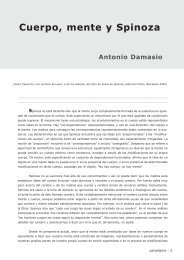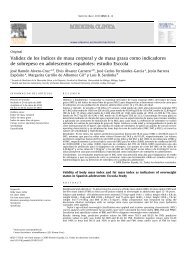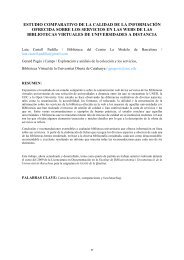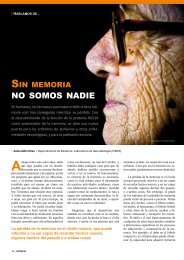Estereotipos negativos hacia la vejez y su relación con variables ...
Estereotipos negativos hacia la vejez y su relación con variables ...
Estereotipos negativos hacia la vejez y su relación con variables ...
You also want an ePaper? Increase the reach of your titles
YUMPU automatically turns print PDFs into web optimized ePapers that Google loves.
Referencias<br />
Nehrke, M. F., Hulicka I. M. y Morganti, J. B. (1980). Age differences in life satisfaction, locus of<br />
<strong>con</strong>trol and self-<strong>con</strong>cept. International Journal of Aging and Human Development, 11(1), 25-<br />
33.<br />
Nelson, E. y Dannefer, D. (2002). Aged heterogeneity: Fact or fiction? The fate of diversity in<br />
gerontological research. Gerontologist, 32, 17-23.<br />
Netz, Y. y Ben-Sira, D. (1993). Attitudes of young people, adults and older adults from three<br />
generation families toward the <strong>con</strong>cepts “ideal person”, ”youth”, ”adult” and “old person”.<br />
Educational Gerontology, 19, 607-62.<br />
Neuberg, S. L. (1994). Expectancy-<strong>con</strong>firmation processes in stereotype social encounters:The<br />
moderating role of social goals. En M. P. Olson (Eds.). The psychology of prejudice: The<br />
Notario Symposium (Vol. 7, pp. 103-130). Hillsdale. NJ: Erlbaum.<br />
Neugarten, B. (1974). Age groups in American society and the rise of the young-old. Annals of the<br />
American Academy of Political and Social Science, 187- 198.<br />
Neugarten, B. (1975). The future and the young old. The Gerontologist, 15, 49.<br />
Newman, S., Faux, R. y Larimer, B. (1997). Children´s views on aging: Their attitudes and values.<br />
Gerontologist, 37, 412- 417.<br />
Newmann, J. P., Engel, R.J. y Jensen, J. E. (1991). Age differences in depressive symptoms<br />
experiences.Journal of Gerontology, 46(5), 224-235.<br />
Newsom, J. T. y Schulz, R. (1996). Social <strong>su</strong>pport as a mediator in the re<strong>la</strong>tion between functional<br />
status and quality of life in older adults. Psychology and Aging, 11(1), 34-44.<br />
Nieto, J. A. (1995). La sexualidad de <strong>la</strong>s personas mayores en España. Madrid: Ministerio de A<strong>su</strong>ntos<br />
Sociales.<br />
Nieto, J., Abad, M. A. y Torres, A. (1998). Dimensiones mediadoras de <strong>la</strong> <strong>con</strong>ducta de enfermedad y<br />
<strong>la</strong> calidad de vida en pob<strong>la</strong>ción geriátrica. Anales de Psicología, 4(1), 75-81.<br />
Noro, A. y Aro, S. (1996). Health-re<strong>la</strong>ted quality of life among the least dependent institutional elderly<br />
compared with the non-institutional elderly popu<strong>la</strong>tion. Quality of Life Research: An<br />
International Journal of Quality of Life Aspects of Treatement, care and Rehabilitation, 5(3),<br />
355-366.<br />
Nosek, B., Banaji, M. y Greenwald, A. (2001). Harvesting inter-group attitudes and beliefs from a<br />
demostration website. Group Dinamics, 6, 101-115.<br />
Nuckton, T. S. y List, N. D. (1995). Age is a factor in a critical care unit admissions. Archives of<br />
International Medicine, 155, 1087-1092.<br />
O´Brien, W., VanEgeren, L. y Mumby, P. (1995). Predicting health behaviors using mea<strong>su</strong>res of<br />
optimism and perceived risk. Health Valus: The Journal of Health Behavior, Education and<br />
Promotion, 19(1), 21-28.<br />
O´Connell, A. N. y Rotter, N.G. (1979). The influence of stimulus age and sex on person perception,<br />
Journal of Gerontology, 34(2), 220-228.<br />
242

















